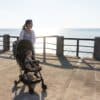Choking emergencies can occur in the blink of an eye, transforming a mealtime into a parent’s worst nightmare. This unfortunate yet critical situation recently highlighted by Dr. Michael Milobsky—a pediatrician and father of seven—serves as a powerful reminder of the importance of preparedness during such incidents. His experience underscores both the potential danger of choking for young children and the immediate action that can save a life.
Understanding Choking Risks in Young Children
Choking remains a leading cause of injury and death among children, particularly those under the age of five. The American Academy of Pediatrics identifies mealtime—along with the presence of small objects—as prime scenarios for choking incidents. It is in these moments that vigilance is crucial; children who are allowed to run, play, or even walk while eating are at a significantly increased risk.
Dr. Milobsky emphasizes the importance of sedentary eating for children, as he experienced the alarming consequences firsthand. His advice is straightforward: children should remain seated while eating to minimize the chances of choking. This simple guideline could prevent many distressing situations from occurring.
Essential Skills Every Parent Should Learn
In the face of choking, knowing how to react swiftly can make all the difference. Dr. Milobsky highlights three key lifesaving maneuvers that every parent should master:
- Avoid Blindly Reaching: Do not instinctively reach into your child’s mouth. This can push the lodged object deeper into their throat, complicating the situation further.
- Back Blows: Deliver firm back blows between the child’s shoulder blades using the heel of your hand. As Milobsky advises, hit with enough force; the goal is to dislodge the item, not just to pat them on the back.
- Abdominal Thrusts (Heimlich Maneuver): For children older than one, wrap your arms around their waist, form a fist just below the breastbone, and perform quick upward thrusts. The speed and decisiveness of your actions are what matter most, rather than the precision of your technique.
For infants under one year, techniques differ and should include a combination of back blows and chest thrusts. Proper instruction is crucial, which is why enrolling in a certified first aid class is highly recommended. Should a child become unconscious, administering CPR immediately while seeking further assistance is essential.
Moving Forward with Confidence
While social media platforms can raise awareness about choking incidents, they cannot replace practical training. Parents seeking to enhance their preparedness should turn to organizations like the American Heart Association and the American Red Cross, which offer courses in pediatric first aid and CPR. Local hospitals, libraries, and community centers often provide these resources as well.
Participating in even a single training session can empower parents with the knowledge and confidence to act decisively in an emergency. Dr. Milobsky’s experience reminds us that choking can happen suddenly and without warning, but through education and preparedness, we can be equipped to manage such situations effectively.
Childhood should be a time of joy and exploration, rather than fear of unforeseen accidents like choking. By taking proactive measures and being equipped with the right knowledge, parents can turn panic into preparedness, ensuring that they are ready to protect their loved ones when it matters most.
Image Source: arda savasciogullari / Shutterstock



































